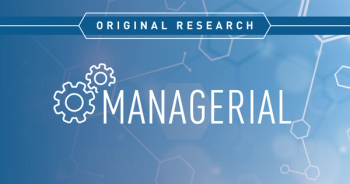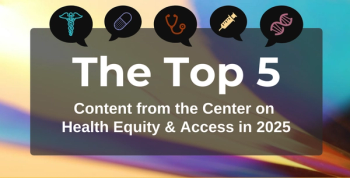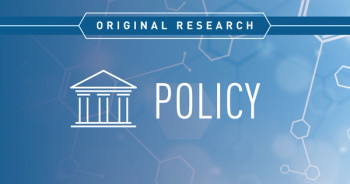
The American Journal of Managed Care
- October 2025
- Volume 31
- Issue 10
- Pages: e308-e312
Medicare Expenditures in the First Year of Amyotrophic Lateral Sclerosis Diagnosis
Medicare expenditures for patients with amyotrophic lateral sclerosis are more than 3 times those of the average Medicare beneficiary, and drug therapies are an important cost driver.
ABSTRACT
Objectives: To determine Medicare expenditures and potential beneficiary out-of-pocket liability for Medicare beneficiaries with amyotrophic lateral sclerosis (ALS), including costs related to drug treatments.
Study Design: This cohort study utilized the 100% Medicare fee-for-service claims for 2017-2021, including Part A and Part B medical claims and Part D prescription drug event data.
Methods: Eligible Medicare beneficiaries with ALS were identified based on 1 or more inpatient or 2 or more outpatient claims with an International Statistical Classification of Diseases, Tenth Revision diagnosis code for ALS (G12.21) between 2017 and 2020. Health care expenditures and beneficiary liability were assessed for the 12-month study period.
Results: At 1 year post index, Medicare beneficiaries with ALS had more than 3 times the Medicare expenditures of beneficiaries without ALS ($47,450 vs $13,889, respectively). Similar patterns were observed for beneficiary liability. Approximately one-third of Medicare beneficiaries used either edaravone or riluzole in the first 12 months following ALS diagnosis. The cost of care for beneficiaries using these drugs was notably higher than for beneficiaries with ALS overall.
Conclusions: Approximately one-third of people with ALS on Medicare receive disease-modifying medication. ALS is a burdensome disease with significant financial implications for people with ALS and the Medicare program. Treatment for ALS presents affordability challenges, and policy makers must consider how current Medicare policy addresses the costs of care.
Am J Manag Care. 2025;31(10):e308-e312.
Takeaway Points
- Medicare beneficiaries with amyotrophic lateral sclerosis (ALS) were found to have more than 3 times the Medicare expenditures and beneficiary liability of the average Medicare beneficiary.
- Approximately 30% of beneficiaries with ALS used riluzole in the first 12 months following the ALS index date, and less than 10% used edaravone.
- Expenditures associated with ALS medications are an important driver of total costs.
- These findings demonstrate the significant financial implications of ALS for patients and the Medicare program and highlight the challenges and potential barriers associated with the cost of drug therapies to manage ALS.
Amyotrophic lateral sclerosis (ALS) is a progressive disease affecting motor neurons, frequently characterized by muscle weakness, difficulty chewing or swallowing, difficulty breathing, slurred and nasal speech, and anxiety and depression.1 Prevalence of ALS in the US is estimated at 9.1 per 100,000 persons.2 Age is the most common risk factor, with most people developing symptoms between the ages of 60 and 69 years, and men are at a higher risk than women of developing ALS.2 Symptom management treatments for ALS include multidisciplinary care and support services, lifestyle changes, rehabilitation and physical therapy, communication and breathing support, durable medical equipment, and medications.1,3 Disease-modifying therapies approved by the FDA for ALS include riluzole (Rilutek; in 1995),1,3-5 edaravone (Radicava; 2017),1,5,6 and tofersen (Qalsody; 2023).1,7 In April 2024, sodium phenylbutyrate and taurursodiol oral suspension (Relyvrio), approved by the FDA in 2022, was withdrawn from the market based on clinical trial results.8
ALS results in significant financial burden to individuals and health insurers, driven in part by high-cost medications to manage ALS.9-12 ALS is a qualifiable condition for federal health care coverage, including Social Security Disability Insurance and Medicare entitlement13; however, cost sharing associated with medical care and prescription drugs remains a financial burden for people with ALS. Studies using Medicare Part A (hospital) and Part B (physician and outpatient) claims data prior to 2018 found annual medical expenses for beneficiaries with ALS to be between $31,76610 and $54,612.12 These studies focused primarily on the medical costs of ALS. As newer treatments present affordability challenges and changes to the Part D (prescription drug) benefit in the Inflation Reduction Act of 2022 take effect, updated analyses will inform policy makers considering whether total medical costs of care are adequately addressed by Medicare coverage.
This study provides an updated understanding of health care expenditures for Medicare beneficiaries with ALS relative to the average Medicare beneficiary. The purpose of this study is not to examine all ALS costs but to document total costs of treating the Medicare population with ALS relative to all Medicare beneficiaries to better understand the medical cost burden of ALS. Our study further analyzes Medicare expenditures and beneficiary liability overall and by type of service provided. Beneficiary liability reflects the portion of costs for Medicare or Part D services that beneficiaries must pay for. These costs may be covered by supplemental health insurance (eg, Medigap or employer-sponsored insurance) or paid out of pocket. The analyses presented here also stratify findings by use of FDA-approved treatments available during the study period, as these treatments may significantly impact Medicare expenditures.
METHODS
Data Source and Study Design
This retrospective population-based cohort analysis utilized the 100% Medicare fee-for-service (FFS) claims (Part A and Part B) and 100% Medicare Part D prescription drug event data for 2017-2021 from CMS accessed by Avalere via a research collaboration with Inovalon and governed by a CMS Data Use Agreement (DUA).
Study Population
Beneficiaries included in the analysis had a diagnosis of ALS between 2017 and 2020, defined as at least 1 inpatient claim or at least 2 outpatient claims (at least 30 days apart) for ALS with an International Statistical Classification of Diseases, Tenth Revision diagnosis code of G12.21. This study period included use of the drug edaravone, approved in 2017, and postdiagnosis service utilization into 2021, the most recent data available at the time the study was conducted. Inpatient claims were defined as short-term acute or critical-access hospital claims. Medicare hospital outpatient department and carrier files were the sources of outpatient claims. The earliest date of the first ALS inpatient or outpatient claim was identified as the index date.
In addition to an ALS diagnosis, beneficiaries had to meet 2 criteria for inclusion in the ALS Medicare group: (1) a 6-month clean period with continuous Medicare enrollment and without an ALS diagnosis prior to the index date; and (2) at least 6 months of continuous enrollment in Medicare parts A and B following their index date, defined as no more than a 45-day gap in enrollment. They were followed from index date until the end of 2021, death, or disenrollment in Medicare parts A and B.
As a comparison group, Medicare beneficiaries in 2021 were identified using a random 20% sample of eligible Medicare beneficiaries available in the Master Beneficiary Summary File; the 20% sample is the maximum allowable size permitted per the DUA with CMS. The comparison group excludes beneficiaries with ALS. Enrollment in Part D was not an eligibility criterion, although Part D drug utilization and expenditures are reported in the Medicare data. Enrollment in Part D was similar among beneficiaries with ALS and those without ALS, at 70% and 73%, respectively.
Outcomes
This study quantified total costs of medical care for beneficiaries with ALS. Medicare expenditures were calculated for 12 months following the index date for the ALS beneficiary cohort and for the 12 months of 2021 for the sample of Medicare beneficiaries without ALS. Expenditures were examined overall and by service, including inpatient, hospital outpatient services, skilled nursing facility, home health services, durable medical equipment (DME), Part D drug, physician and nonphysician services in the Medicare carrier file, and other Medicare services. Claim payment amounts were adjusted to reflect 2021 US$ using medical care inflation data from the Bureau of Labor Statistics,14 and 12-month costs were weighted to reflect months of enrollment to account for disenrollment or death.
Analyses also looked at beneficiary liability, the cost sharing that beneficiaries are responsible for beyond what Medicare programs cover. Although beneficiaries may purchase supplemental coverage through Medigap or receive supplemental coverage from an employer to cover cost-sharing amounts, determining the presence of supplemental coverage using Medicare claims data was not possible.15 Medigap coverage is common, with 14.6 million beneficiaries enrolled in 2021.15
Statistical Analysis
Medicare expenditures for beneficiaries with ALS were compared with those for Medicare beneficiaries without ALS to understand how health care utilization and spending differ.
ALS drug costs, including riluzole (oral) and edaravone (intravenous), were reported among beneficiaries with ALS receiving those treatments in the first year following the ALS index date. These were the only approved disease-modifying medications. Sodium phenylbutyrate and taurursodiol oral suspension and tofersen (intrathecal) were not approved until after 2021 and are outside the study window.
T tests assessed differences in mean total expenditures and beneficiary liability between Medicare beneficiaries with ALS and those without ALS. Analyses were conducted using SAS Enterprise Guide 7.1 (SAS Institute Inc).
RESULTS
Overall Costs
The study sample included 11,260 Medicare beneficiaries with ALS, with a mean age of 70 years. Their mean (SD) annual Medicare spending was $47,450 ($597) (95% CI, $46,280-$48,620) (
Short-term acute hospital care was the largest cost driver of total expenditures across all beneficiary groups ($3249 for Medicare beneficiaries without ALS and $11,237 for Medicare beneficiaries with ALS). DME costs were $5583 for Medicare beneficiaries with ALS, making DME another notable cost driver for this group. Part D drug expenditures were a large component of total expenditures, at $6309 for beneficiaries with ALS compared with $2966 for beneficiaries without ALS.
The mean (SD) patient liability for Medicare beneficiaries without ALS was $2050 ($2) (95% CI, $2047-$2053). In contrast, the mean (SD) liability for beneficiaries with ALS was $6802 ($88) (95% CI, $6630-$6974), more than 3 times greater than for those without ALS (P < .0001) (
Cost Among Beneficiaries Who Received Edaravone or Riluzole
A total of 5.2% of Medicare beneficiaries with ALS (n = 580) had a claim for edaravone in the first 12 months following the index date. Medicare beneficiaries with ALS using edaravone had a mean (SD) of $124,509 ($2420) (95% CI, $119,618-$129,401) in overall expenditures, 37.8% of which was attributable to Part D expenditures ($47,067) (Figure 1). The mean (SD) patient liability total for beneficiaries with ALS treated with edaravone was $20,930 ($722) (95% CI, $19,510-$22,346) (Figure 2).
Among beneficiaries with ALS, 31.7% used riluzole in the first 12 months following the index date and had a mean (SD) of $56,292 ($1050) (95% CI, $54,231-$58,350) in expenditures, $11,748 of which was attributable to Part D expenditures (Figure 1). The mean (SD) patient liability total for beneficiaries with ALS treated with riluzole was $8706 ($168) (95% CI, $8377-$9035) (Figure 2).
DISCUSSION
Our study quantified that the mean annual Medicare spending for beneficiaries with ALS was more than 3 times that of Medicare beneficiaries without ALS. Substantial economic costs have been associated with ALS for patients, payers, and caregivers.9 Understanding the magnitude of such costs, particularly of high-cost medications, is essential for patients, policy makers, and providers treating people with ALS.
Our findings indicate that approximately one-third of beneficiaries with ALS are using either of the available disease-modifying drugs, edaravone or riluzole. This is unexpected, given clinical practice guidelines. Just 5.2% of Medicare beneficiaries with ALS had a claim for edaravone in the first 12 months following the index date, and 31.7% used riluzole. Prior research using administrative claims observed similar rates of riluzole use among people with ALS.16 The reasons for low utilization are unclear and warrant further research. Drivers might include multidisciplinary clinic access, patient treatment preferences, and cost.17,18 Trends in treatment use will be important to track, as changes to Part D benefit design affect both beneficiary and plan liability.
Costs for beneficiaries treated with edaravone or riluzole are notable and differ due to factors including time on market and mode of administration. Spending for beneficiaries on drugs and hospital outpatient care, which may be driven in part by costs of drug administration, can be burdensome due to cost-sharing liability. Previous research identified potential cost offsets for Medicare with use of other services; for example, early use of edaravone is associated with reduced hospitalizations.19
These findings show significant beneficiary liability for people with ALS, especially for beneficiaries using edaravone or riluzole. Costs for edaravone may have reached the catastrophic coverage phase under standard Part D plan benefit designs, for which patients had to incur more than $3000 in out-of-pocket (OOP) costs for co-payments and coinsurance. In 2025, maximum annual OOP costs for Medicare Part D beneficiaries are $2000 under the Inflation Reduction Act, with no beneficiary liability in the catastrophic benefit phase. This change may be an important backstop limiting patient liability that might influence treatment utilization.
Results presented here highlight total medical costs of care, but the total cost burden of ALS includes nonmedical costs, which are not reflected in this study since they are not collected or reported in administrative data sources. Several existing studies suggest significant nonmedical and indirect costs associated with caregiving, lost income, and home and vehicle modifications.20,21 Studies also observe negative quality-of-life impacts for people with ALS, as well as their families and caregivers.22 Past studies found that income loss is also a significant cost for people with ALS.23
Limitations
This study is limited to Medicare FFS. Although inflation adjustment is used to account for the use of 2021 data for the beneficiaries without ALS vs 2017-2021 for beneficiaries with ALS, the adjustment may not fully account for variations in service utilization. The study results highlight beneficiary liability as part of total Medicare expenditures, but data on supplemental insurance (Medigap) are not available, so calculating actual OOP expenditures is not possible. Prescription drug data for beneficiaries with drug coverage outside of the Medicare program are not available and may lead to an underestimate of total expenditures for these beneficiaries.
CONCLUSIONS
Medicare expenditures and beneficiary liability for beneficiaries with ALS are more than 3 times those of Medicare beneficiaries without ALS. Although drugs such as edaravone and riluzole are among the few FDA-approved disease-modifying drugs for ALS, costs associated with these treatments drive total cost burden for insurers and beneficiaries.
Medical costs are just one aspect of the total cost of care for beneficiaries with ALS. Limited research exists to quantify nonmedical costs of ALS; however, these costs are known to be high, given the trajectory of illness and disability associated with this diagnosis. Future research may incorporate a study of nonmedical cost burden. Medical cost data in combination with nonmedical cost data will provide more accurate information on the total cost burden of ALS.
Author Affiliations: Avalere Health (MM, MA, KG, CSS, AF, SD), Washington, DC; The ALS Association (SP, NT, KDD), Arlington, VA.
Source of Funding: The ALS Association.
Author Disclosures: Drs Parvanta, Thakur, and Dave are or were employed by the ALS Association; MTPA, the manufacturer of edavarone, is a sponsor of the ALS Association but did not sponsor this work. The remaining authors report no relationship or financial interest with any entity that would pose a conflict of interest with the subject matter of this article.
Authorship Information: Concept and design (MM, MA, KG, AF, SD, NT, KDD); analysis and interpretation of data (MM, MA, KG, CSS, AF, SD, SP, NT, KDD); drafting of the manuscript (MM, MA, CSS, AF, SD); critical revision of the manuscript for important intellectual content (MM, MA, KG, AF, SD, SP, NT, KDD); statistical analysis (MM, MA); obtaining funding (NT, KDD); administrative, technical, or logistic support (MA, KG, CSS, AF, SD, SP, KDD); and supervision (KG, NT, KDD).
Address Correspondence to: Kolton Gustafson, MPH, Avalere Health, 1201 New York Ave NW, Ste 1000, Washington, DC 20005. Email: kgustafson@avalere.com.
REFERENCES
1. Amyotrophic lateral sclerosis (ALS). National Institute of Neurological Disorders and Stroke. Accessed August 14, 2023. https://www.ninds.nih.gov/health-information/disorders/amyotrophic-lateral-sclerosis-als
2. Mehta P, Raymond J, Zhang Y, et al. Prevalence of amyotrophic lateral sclerosis in the United States, 2018. Amyotroph Lateral Scler Frontotemporal Degener. 2023;24(7-8):702-708. doi:10.1080/21678421.2023.2245858
3. Miller RG, Jackson CE, Kasarskis EJ, et al; Quality Standards Subcommittee of the American Academy of Neurology. Practice parameter update: the care of the patient with amyotrophic lateral sclerosis: drug, nutritional, and respiratory therapies (an evidence-based review): report of the Quality Standards Subcommittee of the American Academy of Neurology. Neurology. 2009;73(15):1218-1226. doi:10.1212/WNL.0b013e3181bc0141
4. Rilutek. Prescribing information. Covis Pharmaceuticals; 2016. Accessed December 20, 2023.
5. Jaiswal MK. Riluzole and edaravone: a tale of two amyotrophic lateral sclerosis drugs. Med Res Rev. 2019;39(2):733-748. doi:10.1002/med.21528
6. Radicava and Radicava ORS. Prescribing information. Mitsubishi Tanabe Pharma America; 2022. Accessed December 20, 2023.
7. Qalsody. Prescribing information. Biogen; 2023. Accessed December 20, 2023.
8. Amylyx Pharmaceuticals announces formal intention to remove Relyvrio/Albrioza from the market; provides updates on access to therapy, pipeline, corporate restructuring, and strategy. News release. Amylyx. April 4, 2024. Accessed May 1, 2024.
9. Santaniello B. ALS managed care considerations. Am J Manag Care. 2018;24(suppl 15):S336-S341.
10. Larkindale J, Yang W, Hogan PF, et al. Cost of illness for neuromuscular diseases in the United States. Muscle Nerve. 2014;49(3):431-438. doi:10.1002/mus.23942
11. Kvam KA, Benatar M, Brownlee A, et al. Amyotrophic lateral sclerosis quality measurement set 2022 update: quality improvement in neurology. Neurology. 2023;101(5):223-232. doi:10.1212/WNL.0000000000207166
12. Meng L, Bian A, Jordan S, Wolff A, Shefner JM, Andrews J. Profile of medical care costs in patients with amyotrophic lateral sclerosis in the Medicare programme and under commercial insurance. Amyotroph Lateral Scler Frontotemporal Degener. 2018;19(1-2):134-142. doi:10.1080/21678421.2017.1363242
13. Medicare. Social Security Administration. Accessed September 13, 2023.
14. Consumer Price Index. US Bureau of Labor Statistics. Accessed April 10, 2023.
15. Medigap: background and statistics. Congressional Research Service. May 12, 2023. Accessed December 20, 2023.
16. Miller C, Apple S, Paige JS, et al. Current and future projections of amyotrophic lateral sclerosis in the United States using administrative claims data. Neuroepidemiology. 2021;55(4):275-285. doi:10.1159/000515203
17. Stephens HE, Young J, Felgoise SH, Simmons Z. A qualitative study of multidisciplinary ALS clinic use in the United States. Amyotroph Lateral Scler Frontotemporal Degener. 2015;17(1-2):55-61. doi:10.3109/21678421.2015.1069851
18. Introna A, D’Errico E, Modugno B, et al. Adherence to riluzole in patients with amyotrophic lateral sclerosis: an observational study. Neuropsychiatr Dis Treat. 2018;14:193-203. doi:10.2147/NDT.S150550
19. Brooks BR, Pioro EP, Sakata T, Takashi F, Hagan M, Apple S. The effects of intervention with intravenous edaravone in Study 19 on hospitalization, tracheostomy, ventilation, and death in patients with amyotrophic lateral sclerosis. Muscle Nerve. 2023;68(4):397-403. doi:10.1002/mus.27946
20. Wong W. The role of managed care professionals in improving care for patients with ALS. Am J Manag Care. 2020;26(suppl 9):S198-S205. doi:10.37765/ajmc.2020.88484
21. The Lewin Group Inc. Cost of Amyotrophic Lateral Sclerosis, Muscular Dystrophy, and Spinal Muscular Atrophy in the United States. Muscular Dystrophy Association. March 1, 2012. Accessed August 14, 2023.
22. Antoniadi AM, Galvin M, Heverin M, Hardiman O, Mooney C. Prediction of caregiver quality of life in amyotrophic lateral sclerosis using explainable machine learning. Sci Rep. 2021;11(1):12237. doi:10.1038/s41598-021-91632-2
23. Forsythe A, Kim ME, Tomaras D, Kielhorn A. PND31 amyotrophic lateral sclerosis (ALS) results in high direct and indirect costs to patients, caregivers, and healthcare systems. Value Health. 2020;23:S264.
Articles in this issue
Newsletter
Stay ahead of policy, cost, and value—subscribe to AJMC for expert insights at the intersection of clinical care and health economics.








































